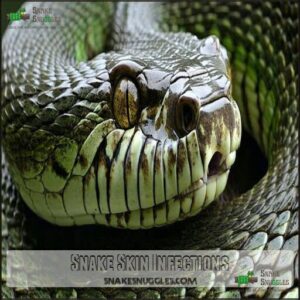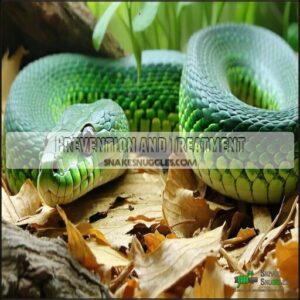This site is supported by our readers. We may earn a commission, at no cost to you, if you purchase through links.

Common causes include abscesses, which are pockets of infection, or tumors that might be harmless or a bit more serious.
Parasites, both internal and external, are another possibility.
Sometimes, it’s simple—females might have retained eggs, or your snake could be constipated or full from a big meal (we’ve all been there).
Rarely, organ enlargement or skeletal problems can cause visible lumps too.
If you spot one, pay attention to its location, size, and feel, and remember that proper care can make all the difference—stay curious!
Table Of Contents
- Key Takeaways
- Snake Skin Infections
- Identifying Abnormal Lumps
- Snake Fungal Disease
- Lumps and Swellings
- Prevention and Treatment
- Frequently Asked Questions (FAQs)
- What if a snake has a lump?
- What causes bumps on the skin of the fingernails?
- Are lumps on pet snakes normal?
- Do snakes have skin problems?
- Can a snake have a pus scab?
- Why do snakes swell?
- Why would a snake be lumpy?
- What causes tumors in snakes?
- What are the symptoms of snake parasites?
- Can congenital defects cause subcutaneous lumps in snakes?
- Conclusion
Key Takeaways
- Pay attention to bumps or lumps on your snake as they might indicate infections, tumors, parasites, or blockages.
- Keep their enclosure clean and maintain proper humidity and temperature to prevent infections and stress-related issues.
- Consult a reptile vet immediately if you notice unusual signs like swelling, crusty scales, or behavioral changes.
- Regular check-ups, balanced nutrition, and early detection are crucial to keeping your snake healthy and thriving.
Snake Skin Infections
You’ll notice skin infections in snakes often appear as unusual bumps caused by bacteria, fungi, or parasites in the surrounding environment.
These infections can quickly transform from minor issues to serious health concerns if you don’t address them promptly with proper veterinary care.
Bacterial Infections
Bacterial infections can easily creep into your snake’s skin, causing painful abscesses and alarming inflammation.
Bacterial infections in snakes cause painful abscesses and rapid inflammation, demanding urgent care to prevent serious health complications.
When bacteria breach the skin barrier, you’ll notice red, swollen areas that may develop into fluid-filled lumps.
These snake skin infections can progress to septicemia if untreated.
Watch for discharge, discoloration, and sensitivity to touch.
Prompt antibiotic treatments are essential, as antibiotic resistance is a growing concern in reptile wound care.
Fungal Infections
Beneath the surface of your snake’s skin, fungal infections lurk as emerging threats.
Moisture control is essential, as damp environments become breeding grounds for snake fungal disease (SFD) and Batrachochytrium infection.
You’ll notice crusty scales or snake lumps where fungi have taken hold.
Soil contamination often introduces these pathogens, which can spread quickly across your pet’s body, causing serious skin infections if left untreated.
Parasitic Infections
Parasitic infections in snakes are no joke.
Mite infestations and tick exposure can leave tiny lumps or sores on the skin, while internal parasites cause swelling or organ damage.
Stay vigilant to these warning signs:
- Skin irritation from mites or ticks.
- Bumps near the eyes or cloaca.
- Swollen organs from internal parasites.
- Weight loss from protozoal infections.
- Weakness despite good care.
These signs can indicate serious health issues, and it is crucial to monitor them closely to prevent further complications, especially skin irritation and internal parasites.
Signs of Infection
Spotting early symptoms of snake skin infections can save your pet’s life.
Watch for behavioral changes like lethargy, appetite loss, or breathing issues. Skin abnormalities such as redness, blisters, or unusual crusts might signal trouble.
Snake lumps could hint at advanced infections. Prompt attention, coupled with accurate snake lumps diagnosis, guarantees your scaly friend gets the care it needs before conditions worsen, and this can be crucial for saving your pet’s life with accurate diagnosis.
Identifying Abnormal Lumps
When you spot a strange bump under your snake’s skin, it’s vital to figure out what’s going on.
Paying attention to details like size, location, and texture can help you catch serious issues early.
Location and Size
Understanding snake lumps’ location and size matters.
A lump near essential organs may signal serious issues, while its growth rate reveals severity.
Large or rapidly growing snake skin lumps often require urgent care.
Smaller bumps need monitoring too—organ involvement isn’t always obvious.
Palpation findings help pinpoint specifics.
Always note size significance when evaluating snake lumps characteristics for necessary action, considering the growth rate.
Consistency and Attachment
Some snake lumps feel firm, while others are soft or fluid-filled—it all depends on their cause.
Check if the lump is fixed or moves under the skin by gently prodding it.
A clean, stress-free habitat can help prevent future skin infections.
Factors to examine include:
- Lump Hardness: Is it solid or squishy?
- Lump Mobility: Does it shift around?
- Tissue Attachment: Is it anchored firmly?
- Fluid Consistency: Any swelling sensation?
- Depth Location: Surface-level or deeper?
Observation and Diagnosis
Examining lump characteristics is key for early detection. Gently inspect your snake’s skin for texture, size, and changes in color.
Use palpation techniques to assess firmness or attachment. Imaging modalities like X-rays help identify hidden issues.
For detailed internal views, consider specialized reptile radiography. A clear differential diagnosis depends on observing snake lumps symptoms carefully before consulting a vet.
Timely snake lumps veterinary care guarantees better outcomes and is crucial for the health of your snake, making regular inspection a vital part of snake care.
Snake Fungal Disease
Snake Fungal Disease (SFD) can cause serious skin issues, turning healthy scales into crusty, disfigured patches.
Snake Fungal Disease transforms healthy scales into crusty, deformed patches—early detection and prompt treatment are crucial for your snake’s health.
If you notice lumps, swelling, or unusual blisters on your snake, it’s time to take action.
Causes and Symptoms
When unusual bumps appear, they might hint at something serious.
Snake Fungal Disease (SFD) is a top contender, with lump origins tied to the fungus Ophidiomyces ophiodiicola.
Symptoms range from crusty scales to severe facial disfiguration.
Early detection is vital, as untreated lumps can worsen quickly, and prompt treatment for snake skin health is crucial, highlighting the veterinary importance of addressing symptom severity and bump identification.
Geographic Distribution
Wondering why snake lumps might appear in certain areas?
The geographic distribution of Snake Fungal Disease (SFD) reveals its prevalence, especially in the eastern United States.
Environmental factors, like contaminated soils, impact spread patterns.
Researchers note regional variations, with monitoring challenges hiding SFD’s true range.
This silent fungi’s grip on snakes is broader than reported, making awareness essential, and understanding its prevalence is crucial.
Clinical Signs and Diagnosis
To identify snake lumps early, pay close attention to clinical signs and use reliable diagnostic methods.
A professional evaluation combines observation and testing techniques like:
- Visual inspection for crusty scales or discoloration.
- Palpation techniques to assess lump firmness.
- Diagnostic imaging like x-rays for internal swellings.
- Sample collection for bacterial or fungal analysis.
- Differential diagnosis to pinpoint causes accurately.
Laboratory confirmation may involve fungal culture methods for accurate diagnosis.
Lumps and Swellings
Lumps and swellings under a snake’s skin can signal anything from minor issues to serious health conditions.
Recognizing these bumps early helps you keep your scaly companion happy and healthy.
External Lumps
External lumps on a snake can signal issues like parasite lumps around the vent, abscess formation from infections, or even cancer manifestation.
You might notice strange bumps near the lips, eyes, or cloaca, often tied to mites or ticks.
Pay attention to the lump’s texture, as firm swelling could point to skeletal issues. Always consult a vet for unusual snake skin concerns.
Internal Swellings
Internal swelling in snakes shows up as bulges or strange shapes along the body.
Snake lumps causes range from organ enlargement to digestive obstructions, systemic diseases, or chronic dehydration.
Internal abscesses can create hidden issues too.
If your snake struggles with internal lumps, check for signs like bloating or discomfort.
Always consult a vet to guarantee quick identification and treatment.
Skeletal Lumps
Skeletal lumps are tricky—think of them as the tip of an iceberg signaling deeper issues.
These bumps often stem from bone problems like spinal deviations or metabolic conditions.
Watch for:
- Bone swellings from osteomyelitis.
- Deformities causing mobility issues.
- Trauma-related bumps near ribs or spine.
- Osteitis deformans, rare but severe.
- Swelling linked to skeletal deformities.
If you notice any unusual lumps, it’s essential to take into account cancer and tumors.
Stay vigilant!
Diagnostic Methods
If snake lumps make you uneasy, getting the right diagnosis starts with a medical history and a physical examination.
Blood tests, fungal cultures, and fine needle aspirates pinpoint the problem.
Radiographs check for internal masses, while biopsies confirm suspicions.
These methods, like a magnifying glass over mystery bumps, help unravel the cause and guide treatment effectively.
Prevention and Treatment
You can keep your snake healthy by sticking to a few simple habits, like maintaining a clean habitat and feeding it properly.
Regular check-ups with an experienced vet guarantee you catch issues early, so those pesky lumps don’t become a bigger problem, and this is crucial for maintaining the snake’s overall health.
Environmental Changes
Tiny lapses in snake care can lead to big problems.
Too much moisture or not enough airflow? That’s a recipe for snake skin troubles.
Dial in humidity control, heat with proper temperature gradients, and pick the right enclosure size.
Substrate choice and lighting needs? They matter too.
Maintaining proper snake enclosure conditions is essential for their well-being.
Environmental changes aren’t just tweaks—they’re your snake’s ticket to better health.
Veterinary Care
When bumps appear, an exotic veterinarian is your best ally.
These specialists offer advanced diagnostics, like X-rays, to pinpoint snake lumps’ causes.
Sometimes surgical intervention is needed, followed by proper post-op care.
A reptile vet guarantees your pet gets targeted treatments and specialist referrals if necessary.
Don’t ignore veterinary advice; swift action keeps your snake healthy and thriving.
Proper Nutrition and Hygiene
A balanced diet and clean water keep your snake’s health in check, reducing risks like snake lumps.
Regular enclosure cleaning and solid handling practices prevent diseases and skin problems.
Help with shedding when needed to avoid buildup that can cause stress or infection.
Simple routines like these can stop many snake lumps causes and symptoms before they start.
Maintaining proper reptile habitat requirements is also essential for their well-being.
Regular Check-ups and Monitoring
A clean habitat and proper food are great, but without routine vet visits, you’re flying blind.
Early detection of snake lumps through regular inspections during handling and observation can save their life.
Stick to a veterinary schedule for proactive care while tracking your snake’s health.
Owner awareness helps spot changes quickly.
Consider using a snake health product for ideal care.
Think of it as preventative maintenance for your scaly friend!
Frequently Asked Questions (FAQs)
What if a snake has a lump?
Think of your snake as a silent storyteller.
A lump might hint at infections, tumors, or blockages.
Don’t play guessing games—consult a vet.
Early action guarantees your scaly friend slithers happily and healthily.
What causes bumps on the skin of the fingernails?
Bumps on fingernails often come from nail injuries, fungal infections, or skin conditions like eczema.
Even stress can cause ridges.
Keep your nails healthy by moisturizing, protecting them, and seeking help if bumps persist or worsen, which can be a result of failing to address the bumps.
Are lumps on pet snakes normal?
Like bumps on a bumpy road, lumps on pet snakes aren’t always normal and can indicate health issues.
They might signal infections, tumors, or parasites.
Always consult a reptile vet if you spot one.
Do snakes have skin problems?
Yes, snakes can have skin problems, including fungal or bacterial infections, parasites, and injuries.
Symptoms like redness, swelling, or crusty patches often signal issues.
Keeping their environment clean and stress-free helps prevent these problems, and maintaining a clean environment is key to preventing skin problems.
Can a snake have a pus scab?
A snake can develop a pus-filled scab from bacterial infections or abscesses.
These occur when bacteria invade damaged skin.
Keep their habitat clean, and always consult a vet if you notice unusual bumps or wounds.
Why do snakes swell?
Snakes swell due to issues like infections, injuries, or blockages in their digestive system.
Even undigested prey or internal abscesses can cause it.
Always monitor for other symptoms and consult a reptile vet quickly.
Why would a snake be lumpy?
Lumps on snakes can come from infections, parasites, retained eggs, or tumors.
They might also signal injuries or swelling from internal problems.
Always consult a reptile-savvy vet if you notice unusual bumps or growths.
What causes tumors in snakes?
Tumors in snakes can result from genetic mutations, chronic inflammation, or infections.
They vary in severity, requiring a vet to confirm if benign or malignant.
Environmental stressors and exposure to toxins may also play a role.
What are the symptoms of snake parasites?
You might notice mites or ticks around the eyes, lips, or cloaca, leading to irritation, anemia, or abnormal shedding.
Parasites can also cause swelling, lethargy, loss of appetite, and unusual bumps under the skin.
Can congenital defects cause subcutaneous lumps in snakes?
Imagine a hatchling with a unique curve to its spine—congenital defects like skeletal abnormalities can lead to subcutaneous lumps.
These bumps form from misaligned bones or structural issues and often require a vet’s evaluation for care.
Conclusion
Discovering lumps under snake skin might feel like spotting a needle in a haystack of concerns, but prompt action is key.
By recognizing potential causes—such as infections, parasites, or abscesses—you’re already steps ahead in ensuring your snake’s health.
Monitor the lump’s size, location, and changes, and prioritize proper care like clean habitats and regular vet visits.
Remember, addressing lumps under snake skin causes early can prevent bigger problems and keep your scaly companion happy and thriving.















